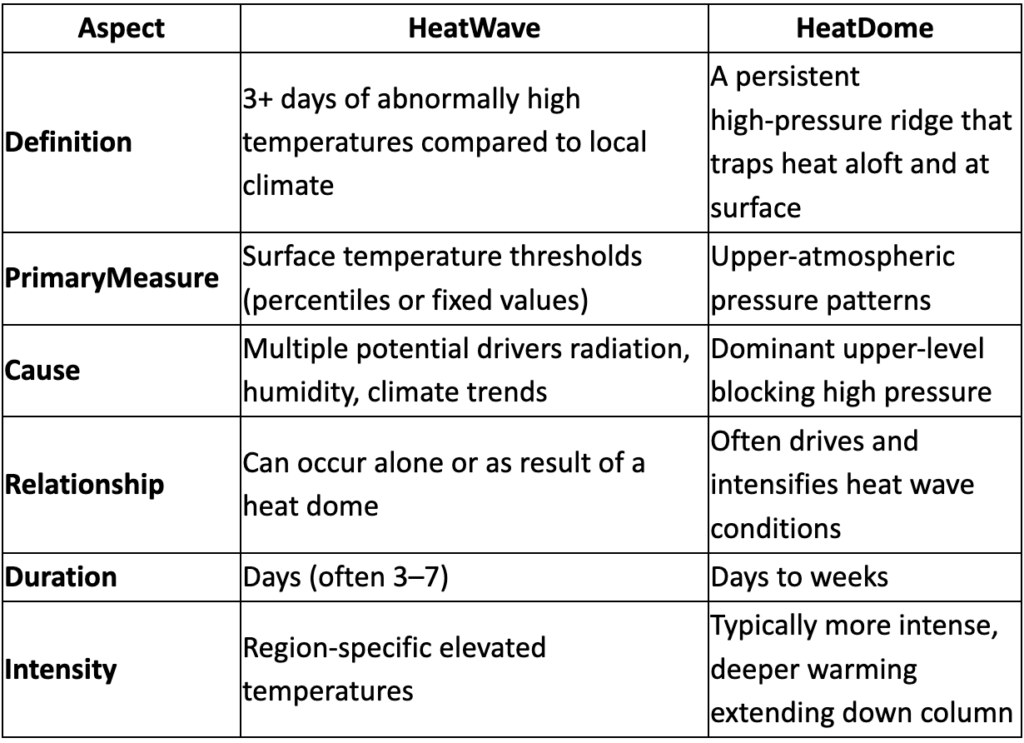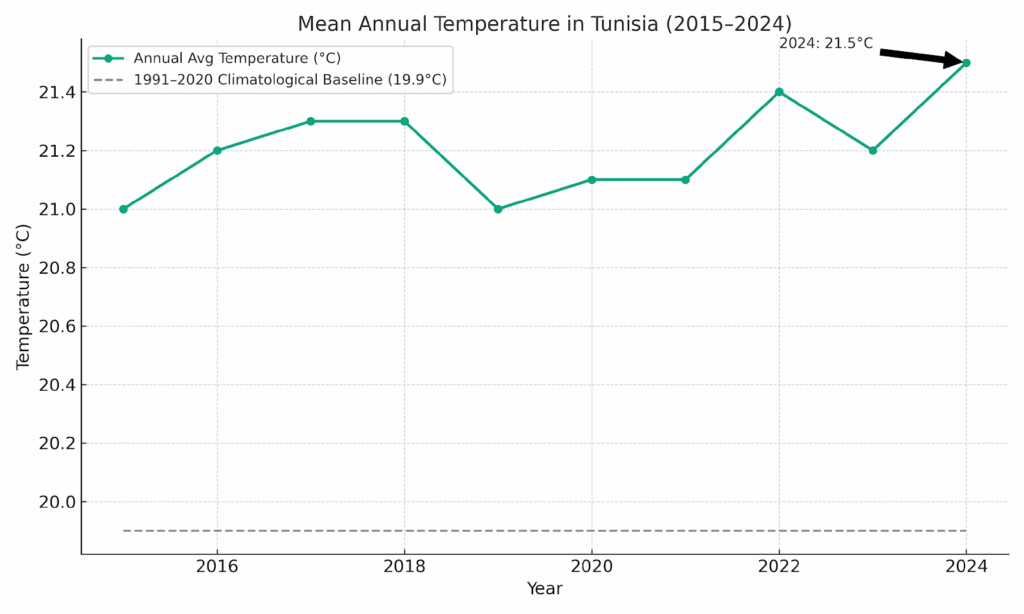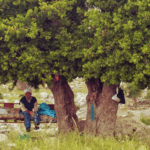In late July 2025, Tunisia faced one of its hottest heatwaves on record, caused by a powerful heat dome. Temperatures soared to 45–50°C in inland areas like Kairouan and Sidi Bouzid, far above normal averages. This heat dome stalled over North Africa and the central Mediterranean for nearly six days, blocking winds and preventing clouds, leading to intense, prolonged heat across the country.
What is a Heat Dome?
A heat dome is a weather phenomenon that occurs when a large area of high atmospheric pressure becomes stationary over a region, creating a thermal “cap” that traps hot air close to the ground. This system acts like an invisible lid, preventing heat from escaping and causing temperatures to rise day after day.
Under normal conditions, warm air near the surface rises and disperses. However, when a heat dome forms, the high-pressure system suppresses vertical air movement, trapping warm air beneath it. At the same time, the air under the dome sinks and compresses; as it compresses, it heats up further, intensifying surface temperatures.
This process also inhibits cloud formation and rainfall, resulting in clear skies and continuous sunlight, with no natural cooling during both day and night. Because the upper atmosphere’s airflow is often stagnant during a heat dome, it can persist over the same area for several consecutive days, leading to prolonged periods of extreme heat.
What is the difference between Heat Domes and Heat Waves?

A heat wave is a prolonged period of unusually high temperatures at the surface level. A heat dome, by contrast, is a stationary high-pressure system that traps warm air beneath it, creating more intense, longer-lasting heat and greater risks to public health.
Tunisia Endured a Relentless Summer Heatwave
On Wednesday, July 23, 2025, several inland regions of Tunisia were hit by an intense heat wave, with temperatures far above seasonal norms, according to the INM. Between 2022 and 2025, Tunisia and North Africa have seen a sharp rise in the frequency and intensity of heat domes.
In July 2022, a widespread heat dome engulfed Tunisia pushing temperatures in Tunis to almost 48°C. This trend continued in July 2023, with a regional heat dome linked to a stalled jet stream and record-high sea surface temperatures. And recently, this July 2025, Tunisia experienced what experts have called an unprecedented heat dome lasting 5 to 6 days, caused by a persistent high-pressure system stalled over North Africa and the Mediterranean.
“This is not an ordinary heat wave, it is a climate-induced extreme”.
The environmental expert Hamdi Hached, “this is not an ordinary heat wave, it is a climate-induced extreme”. According to the Copernicus Climate Observatory (ACCO), summers have become increasingly aggressive, with heat domes turning into natural torture chambers that recur almost every summer across various parts of the world, leading to collective suffocation for both people and ecosystems.
Furthemore, Hached highlights that the primary concern is not only the extreme temperatures, but the duration of such events. Although the upcoming dome may be relatively short lived, it will still bring severe impacts: sleep disturbances, physical exhaustion, respiratory issues, and a rise in heat related illnesses. Power grids will be under pressure due to increased use of air conditioning and cooling systems. Even agriculture is at risk, especially crops sensitive to prolonged high heat.
“The heat dome is not divine punishment. It is the result of human choices, greenhouse gas emissions, excessive consumption, and decades of ignoring nature’s warnings”.
Hached concludes : “The heat dome is not divine punishment. It is the result of human choices, greenhouse gas emissions, excessive consumption, and decades of ignoring nature’s warnings. Solutions exist, but time is running out. What we are about to experience is another urgent wake-up call. The climate is no longer waiting for us.”
Heat Dome impact on Environment and Public Health
Mounting Environmental Risks: A Growing Crisis
It is important to highlight that extreme heat waves pose significant threats to both the environment and public health. Projections indicate that by 2030, wildfires may lead to the loss of approximately 180,000 hectares, equivalent to 17% of Tunisia’s forested areas, driven by rising temperatures and declining rainfall that exacerbate fire intensity.

Recent climate data show Tunisia is warming rapidly. From 2015 to 2024, the national average temperature rose by 0.5 °C, reaching a record 21.5 °C in 2024 the highest since 1950 and 1.6 °C above the 1991–2020 average (INM, Rapport Climatologique Annuel 2024). Long-term records confirm a steady increase from 19.5 °C in 1991 to 21.2 °C in 2024, a 1.7 °C rise over 34 years (WorldData.info). With a warming rate of 0.4 °C per decade, Tunisia ranks among the Mediterranean’s fastest-heating countries (World Bank Climate Change Knowledge Portal), highlighting the urgent need for climate adaptation and mitigation.
When Heat Turns Deadly
In addition, heat waves pose a major risk to public health. This heatstroke can cause confusion, loss of consciousness, and even death. Added to this is the risk of severe dehydration, particularly among children and the elderly. According to the World Bank Climate Risk Country Profile Report, the rise in temperature in Tunisia is likely to exacerbate respiratory diseases, and water-borne diseases may spread due to degradation of the quality of water resources.
Hached warns that special attention must be paid to vulnerable groups: the elderly, children, and those with pre-existing health conditions. He urges the public to avoid strenuous activities, stay well hydrated, and follow all heat safety precautions. He also stressed on the need to care for animals, ensuring shaded areas and access to water for pets and stray animals alike.
The Rising Threat of Heat Domes Fueled by Climate Change
As the climate continues to warm, heat domes are expected to become more frequent and intense. While these weather patterns have existed for a long time, rising global temperatures are making them more powerful. This is primarily due to two factors. First, greenhouse gas emissions trap heat in the atmosphere, contributing to the development and strengthening of high-pressure systems that create heat domes.
Second, the Arctic is warming faster than regions closer to the equator, which disrupts the balance of atmospheric circulation. This imbalance weakens the jet stream, a key driver of weather patterns, causing it to slow down and take on a wavier, more stagnant path. As a result, high-pressure systems, including heat domes, tend to linger longer over the same areas, leading to prolonged periods of extreme heat.
Building Tunisia’s Frontline Against Climate Change
Tunisia’s National Adaptation Plan (NAP) is a comprehensive strategy developed to address the escalating impacts of climate change, including rising temperatures and increased frequency of heatwaves. The NAP focuses on integrating climate considerations into national and local development planning, with particular emphasis on sectors such as agriculture, water resources, and coastal zones.
It outlines specific adaptation priorities, implementation strategies, and mechanisms for monitoring and evaluating progress. The plan also emphasizes the importance of capacity building, public awareness, and stakeholder engagement to ensure effective adaptation measures.
In fact, in 2025, Tunisia’s power grid faced significant strain due to extreme heatwaves, with temperatures soaring above 45°C. To prevent a nationwide blackout, the Tunisian Electricity and Gas Company (STEG) implemented strategic power outages, a measure known as load shedding, to alleviate pressure on the grid and maintain stability . These outages, while necessary, underscored the vulnerabilities in Tunisia’s energy infrastructure amidst escalating climate challenges.
Addressing the Rise of Extreme Heat Domes: Is Prevention Possible?
Mitigating the increasing frequency and severity of heat domes requires a combination of global and local strategies. At the global level, reducing greenhouse gas emissions through a transition to renewable energy is essential to address the root cause of rising temperatures and persistent high-pressure systems .
Locally, cities can implement heat action plans that include early warning systems, public education, and accessible cooling centers to protect vulnerable populations . Urban design improvements such as increasing green spaces, installing reflective cool roofs, and enhancing ventilation can significantly reduce urban heat island effects that amplify heat dome impacts. These approaches can lessen the health and environmental risks posed by extreme heat events.
Heat domes are becoming a harsh reality in Tunisia. They bring extreme heat that affects health, agriculture, and daily life. Understanding these events is vital. But knowledge alone is not enough. Tunisia needs urgent action to reduce climate risks. Policies, community awareness, and sustainable habits must all play a role. Without this, future summers will be even tougher. The time to act is now. Tunisia’s future depends on it.
Copyright © 2025 Blue Tunisia. Tous droits réservés














